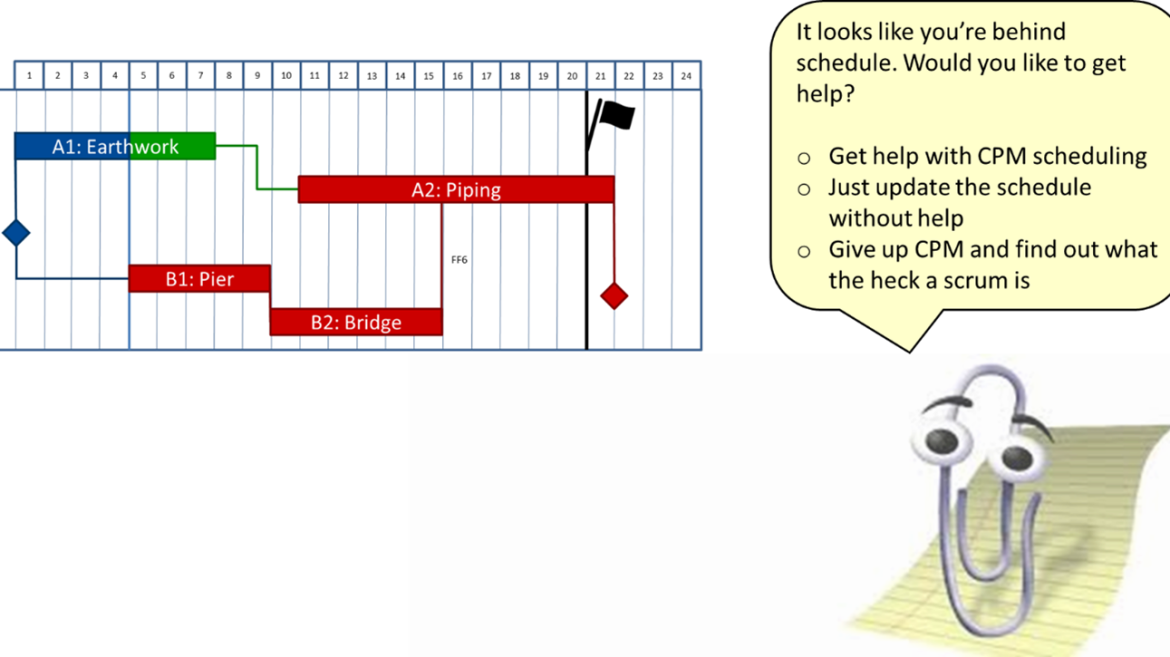CPM Schedules That Actually Work

As the engineering and construction industry implements technology from BIM to inspection drones to GPS-controlled construction equipment, we need to continue to ask whether our management tools are keeping pace.
In the late 20th Century (circa 1997), Microsoft introduced the much-maligned “Clippy” and its famous observation/question, “It looks like you’re writing a letter. Would you like help?” While Clippy may have been more of an irritation than a help, users often did need help with spelling, grammar, and punctuation. Today, Microsoft’s embedded Editor—while still not perfect—quickly and efficiently highlights potential errors with markups that can be corrected on the spot at the user’s option.
While there are several CPM scheduling tools on the market, one continues to dominate, and the features offered by that tool do little to highlight potential errors in a complex schedule. Numerous third-party tools are available, but those can include somewhat arbitrary metrics that may not be based on good practice.
Do I really want 10% of a 5,000-activity CPM on the critical path? I’m not sure that I do. If the project is two years long, I might be perfectly happy with far fewer activities on the critical path—even 100 or fewer—as long as the schedule represents a good model of my plan to execute the scope of work, under the given contractual constraints, and with consideration for the available resources and the physical requirements and conditions of the job.
25 years after the advent of Clippy, most CPM tools are still based on 20th Century concepts. Would I like some help with my CPM schedule? Not from most of the computerized tools that exist today. Until these tools can provide more nuanced and sophisticated guidance, I have to rely almost solely on a human being with the experience to translate a plan into a schedule model. To that end, the following five high-level guidelines continue to be great advice for creating CPM schedules that are actually useful.
Level of Detail
Plan work to the level that it can be controlled. Create enough detail so that the plan is clear and can be executed, but not so much that you will fail to update it properly. Engineering durations and descriptions should be concise enough to gage real progress on defined work product. Procurement durations may be longer to model forecast delivery dates, but progress should be monitored by routinely contacting the supplier. Field activity durations should be shorter than the update period. An average duration of 25% of the update period is a reasonable rule-of-thumb. For monthly updates, the average field activity duration would be roughly one week.
Schedule Network Quality
Develop complete networks. Except for the network start and finish, each network activity should have at least one SS or FS predecessor and at least one FS or FF successor. (Avoid ‘open-ended’ and ‘dangling’ activities.) This is axiomatic to the critical path method.
Use of Constraints
Minimize constraints. Date calculations should be driven by network logic as much as possible. Late finish constraints can be used to model contractual requirements. Additional constraints should be used only with a documented basis as to why the condition is better modeled by a constraint than by network logic. Mandatory constraints should not be used as they override network date and float calculations and reduce the CPM to a bar chart.
Schedule Statusing
Update the schedule based on affirmative progress reports. Do not apply software update commands to report progress without actual verification. Update the status of activities based on remaining duration. Schedule the project with the new data date and verify that: (1) the anticipated finish dates for near-term work appear reasonable based on progress to date, (2) the work scheduled for the upcoming period is a reasonable model of the actual work planned, (3) the longest path for the project is reasonable, and (4) the forecast interim and final completion dates are reasonable.
Schedule Understanding and Commentary
Provide commentary on significant variances and revisions. If the forecast interim or final completion dates are beyond the required dates, provide comments on the cause of the delay and plan to mitigate. The comments should relate to specific activity delays during the previous update period or to schedule revisions. If schedule revisions were made to mitigate delays, describe the revisions to aid understanding by the project personnel who will implement them.
In summary, if you’re building CPM schedules that reflect your real plan for executing the contract scope, meeting the contract requirements, with consideration for the real-world conditions and resources available, and you follow these simple guidelines, CPM will help you get the job done, avoid delays, find alternatives, and resolve changes and disputes when they do arise.
CPM schedules continue to be a useful management tool, but most software can offer little more than canned metrics with respect to the quality of your schedule, and the computer has no idea whether or not your schedule reflects the real world. Much as the best word processor does not make a great writer, the best CPM software does not make a great scheduler. Artificial Intelligence tools may be able to help one day soon, but the canned metrics that I’ve seen so far don’t impress. First, give me people that know what they’re doing. Then the money spent on their tools won’t be wasted.
